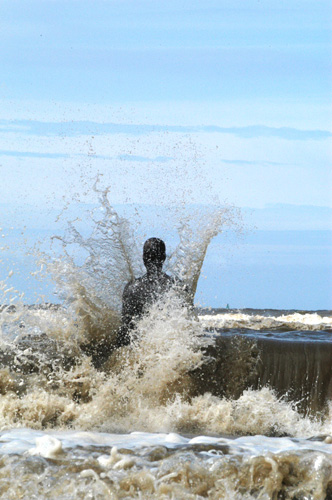Introduction – Nov 2008
The piece below was written in 2005 before Gormley’s Another Place’ had been purchased outright. It will now stay forever on this part of the Lancashire coast and has altered the way I feel about it. The space has changed, and until time eventually takes its toll on these sculptures, as it will do one day in the far off future, it will no longer be what it once was. I can no longer enjoy the wildness of this windswept beach, but then I couldn’t anyway as a large part of vista from the beach is interrupted by an invasion of coastal wind farms. I suppose nothing ever remains as it was, but when Art changes a space on such a huge scale I wonder if we have got something wrong. The title of the work itself, ‘Another Place’, perhaps suggests the need for it to move and grace another shore line somewhere else in the world and remain in the memory alone.
Adding to the landscape – Gormley’s ‘Another Place’
It is, by rights, something that I shouldn’t like. Gormley’s iron men break an otherwise expansive view across to the hills of North Wales. They occupy a space that has, since the Mersey has flown out into the Irish Sea, been people less. I have known this part of the coast all my life; bird watched in all weathers. The massive flocks of Knots and roosting Pink-footed Geese have inspired me to seek out wild places in Wales and Scotland. I go to such places to avoid crowds, to get away from a feeling of claustrophobia that so often grips me in places where people mass. The open spaces along this part of the West Lancashire coast has offered me solace and although close to a large urban populace, a sanction, where it is just possible to connect with the more natural processes that make us who we are.
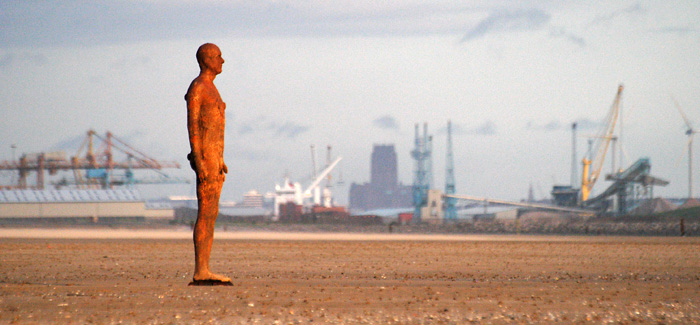
Why then do Anthony Gormley’s men, who stand 100 strong facing out towards the channel, add to this landscape and further reinforce the sense of isolation and wildness? To begin with they are naked, raw and rusting. They come without the trippings of consumerism and reflect the way we once were and how we all entered the world. They stand at the mercy of all that nature can throw at them, yet they remain stoically and doggedly in the face of the onslaught. I have often stood at the tide edge letting the sea wash over my feet but always knowing that the retreat in inevitable. To stay, as Gormley’s men do, and experience the tidal sweeps and currents that have taken many a mortal being on just such coastal reaches, would be to come closer to a deeper understanding of the processes that shape us. Impossible for us as this is, discretion takes hold and the sea does what it does best.
In this curious battle between Gormley’s men and nature there are no winners. The iron men stand motionless taking the waves and ultimately disappearing under the muddy waters. Theirs is a defiant gesture as they succumb to the tide – Yet they will return, the sea unable to take them, and the process will repeat itself in synchronisation to the moon’s push and pull.
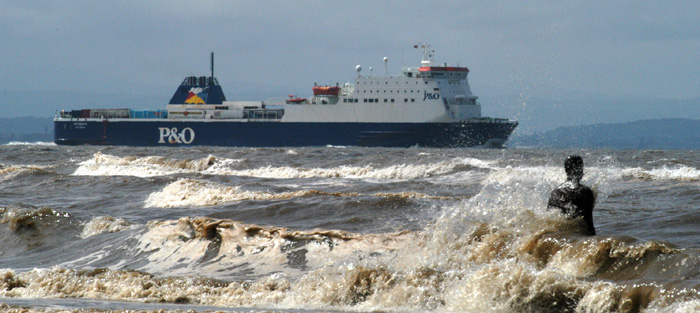
As the tide recedes and line-by-line the men emerge, the blur between what is mortal and what is iron heightens. The army of defiance seems to grow until some appear, to beckon to their dogs, grow taller or diminish and disappear into the sea mist. A family with small children had come down to the sea to build castles of sand and enjoy the freedom that only the edge of the tide can provide. The mother swings the children round dizzying them. All this in front of the gaze of the iron men, unmoved and unphased. When the family return home and the wind and rain begin to empty the beach, their strange companion of the day will still be there, witnessing all the moments that make this place what it is. They speak of wild places because they will see it all. To understand the elements one must first experience them.
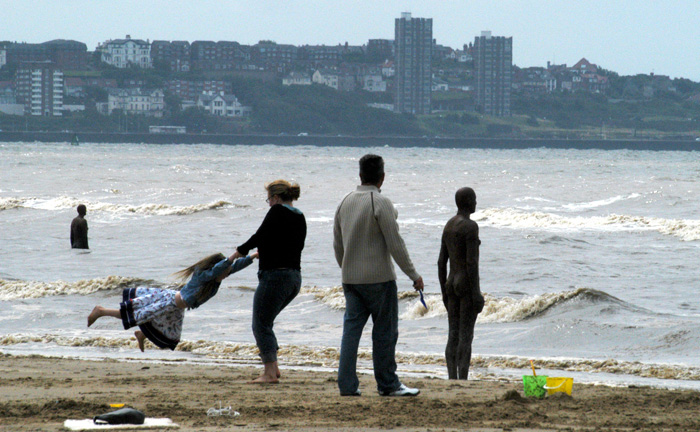
On my second visit to see this piece of sculpture I am struck by the number of people engaging with the work. A group of 50 or so art students with clipboards eagerly peer around the men. Their teacher approaches me asking if I know anything about the rumour that Mr. Gormley is on the beach today because it would top of a memorable day for the class. I answer in the negative, yet he is there: the casts of the men are taken directly from him. Perhaps I should have replied, “yes, I’ve seen him hundreds of times†– but I knew what she meant. There are most definitely more people around than usual for a Thursday morning outside of school holidays. The local economy is set to gain by millions, so the old drawn out argument about wasting money on modern art seems a nonsense and it’s time that people who chant this old mantra realise that without such culturally enriching objects the world has little purpose beyond functionality. Why put on make-up, or jewellery, or hang anything on a wall?
I was thinking how little is understood about tidal range by the layman and although I can read tide tables and have a great respect for the pull and push of water, I class myself in this bracket. Here, however, all is laid bare. Tide tables tell us of the highs and lows in figures that on such a featureless seascape mean very little. The nuances of depth against incline are hard to fathom. Now, with the invasion of the iron men, a visible reference explains the full extent of this life threatening creep and retreat. As the further most figures disappear under the water a mental line is drawn from the submerged heads to the next figures soon to be engulfed and so the game goes on – and time, height and range begin to mean something against the topography of the coast.
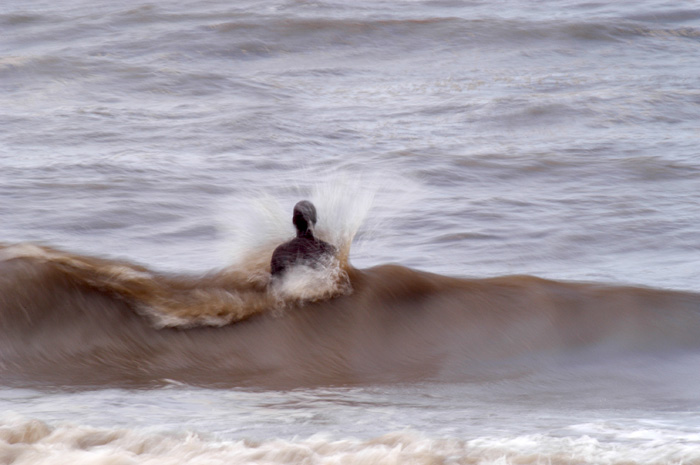
There is a delight in viewing a significant piece of art at your leisure, unimpeded by hoards of people. I recently visited London, exited by the prospect of seeing the Caravaggio’s. I had booked previously over the internet, yet still found myself queuing for nearly an hour before being shuffled into a cramped dark space and even then having to wait sometimes as much as ten minutes before attaining prime view of any one piece. It was, in its own way, worth it. I do remember though remarking to a close friend I went with, “imagine this at ten o’clock tonight when all the crowds have gone and you could be alone with the work.†With Gormley’s men you can do this.
The official title of the piece – ‘Another Way’ suggests an outward looking aspect to these men. They stand sentinel looking towards a better future – somewhere beyond the shores of a place, Liverpool in this case, that has nothing to offer. They wistfully look out as ships head out toward a different life. Perhaps in times past this may have been a fitting testament to a city that has seen its fair share of emigration. Now though, with the city hosting The European City of Culture 2008, the iron men seem to be protectors of something worth defending.
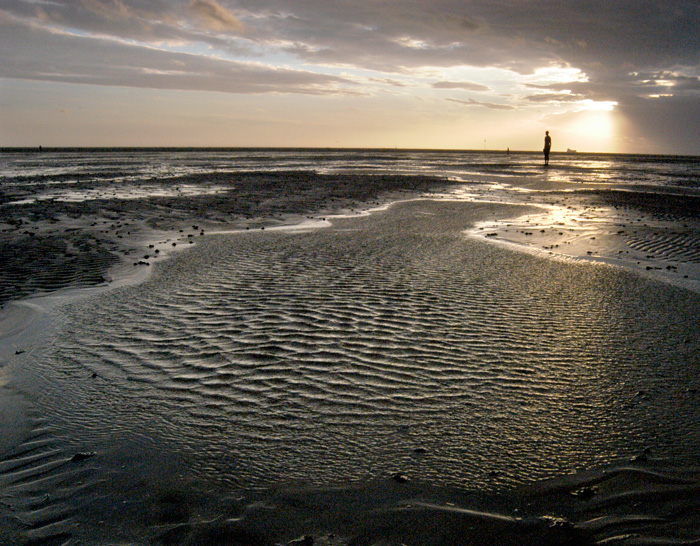
Finally, though, I think Gormley’s men are allowed to work and provoke these responses not solely because of what or where they are, but because they are temporary – unlike the wind farms that along with the skyline of Liverpool offer a curiously impressive backdrop. The huge turbines, which are appearing all over our coastlines, are attacked in many circles for spoiling views and interrupting the unbroken areas that are so special to us. Whilst I could never image a bird crashing into one of Gormley’s men it wouldn’t actually matter in the long run, because they will come down within eighteen months. Likewise they offer temporary change to something that has been with me for years – and that by definition is often healthy. Gormley’s men will come and go: leave their mark with a memory and the many images that the thousands who visit will take away with them. It is this transience that allows me to be so positive and comfortable and debate with ease the merits or otherwise of the iron men. If I awoke to find they were to be left, permanently to rust, be defaced and vandalized and to forever disrupt a space that has over the years offered me something unique and precious, would I be so enthusiastic? – I perhaps doubt it.
